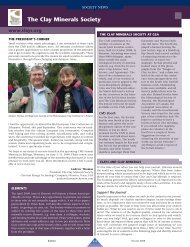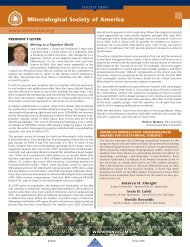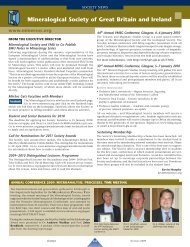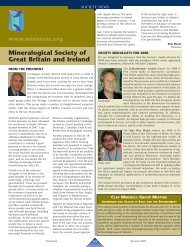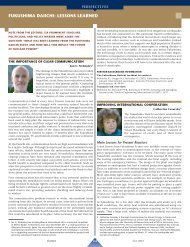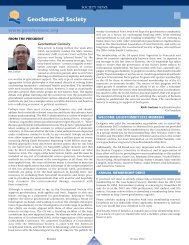Editorial - Elements Magazine
Editorial - Elements Magazine
Editorial - Elements Magazine
You also want an ePaper? Increase the reach of your titles
YUMPU automatically turns print PDFs into web optimized ePapers that Google loves.
FROM THE EDITORS<br />
THIS ISSUE<br />
Guest editors James Brenan and James Mungall<br />
have brought together a cast of international<br />
authors to give you an up-to-date overview of<br />
the economic, scientific, and environmental<br />
significance of the platinum-group elements.<br />
PAST PRINCIPAL EDITOR HONORED<br />
Michael F. Hochella Jr. was honored during the<br />
recent Goldschmidt Conference for his distinguished<br />
service to the Geochemical Society, as<br />
vice president, president, and past president<br />
(1998–2003), as co-organizer of the 2001 V.M.<br />
Goldschmidt Conference, and as “former Principal<br />
Editor of the extraordinarily successful<br />
<strong>Elements</strong> magazine.”<br />
Citationist Scott Wood and Michael Hochella<br />
As citationist Scott Wood pointed out, “Mike’s<br />
Presidential service in the Geochemical Society<br />
was distinguished by several extraordinary<br />
achievements. He was the major driving force<br />
in involving the Geochemical Society in the<br />
Reviews in Mineralogy series, culminating in the<br />
change of the name to Reviews in Mineralogy<br />
and Geochemistry. In 2001 Mike co-organized a<br />
highly successful Goldschmidt Conference<br />
held in Hot Springs, Virginia, with Bob Bodnar.<br />
Although Mike retired from active service<br />
on the GS Board of Directors after 2003, it was<br />
not long before he was to serve the society<br />
again, this time as one of the founding Principal<br />
Editors of the magazine <strong>Elements</strong>. From the<br />
early days when Rod Ewing first pitched to the<br />
Geochemical Society his idea for a scientific<br />
magazine to be co-published by several mineralogical<br />
and geochemical societies, Mike was a<br />
strong supporter of the concept. According to<br />
Principal Editor Ian Parsons, Mike played a<br />
‘pivotal role’ in making <strong>Elements</strong> the success it<br />
has become.”<br />
Here are some excerpts from Mike’s response:<br />
“Whether science or service awards have come<br />
my way, I’m just doing what I love to do. I<br />
can’t imagine anything more important, in the<br />
long run, than understanding this third rock<br />
from the sun, what makes it work, where it<br />
came from and where it’s going, and how to<br />
best care for it. To be so privileged, and to be<br />
able to call all of you colleagues, is the greatest<br />
joy in my life next to my family. And if I can<br />
constructively and productively serve this constituency,<br />
as this award implies, then I am definitely<br />
on the right track, and I will continue<br />
to do that, whether I am testifying to a congressional<br />
subcommittee on Capital Hill, or<br />
telling a large introductory class that what we<br />
do is worth it. …Earth science, in all its grand<br />
forms and permutations, is as important to the<br />
global society as ever. Insofar as our societies<br />
help us organize and project, anything we can<br />
do to serve our organizations is more important<br />
than we can possibly imagine.”<br />
ELEMENTS AT THE GOLDSCHMIDT<br />
CONFERENCE<br />
The editors met for a full day on July 14, 2008.<br />
In attendance were principal editors Bruce<br />
Watson, Susan Stipp, and David Vaughan,<br />
incoming principal editor Hap McSween, past<br />
principal editors Ian Parsons and Rod Ewing<br />
(also chair of the Executive Committee), and<br />
managing editor Pierrette Tremblay. We<br />
reviewed the past year with its highlights and<br />
challenges and brainstormed about where we<br />
want <strong>Elements</strong> to be five years from now.<br />
Among the highlights of the year, those<br />
deserving most mention are that <strong>Elements</strong> is<br />
now available on GeoScienceWorld and that<br />
an online version is available to members of<br />
participating societies.<br />
<strong>Elements</strong> editors love a party, and Susan Stipp, Ian Parsons<br />
and Pierrette Tremblay were there to toast Tim<br />
Drever (MORE ON TIM DREVER’S PARTY ON PAGE 222).<br />
Part of each principal editors meeting is<br />
devoted to reviewing proposals for future thematic<br />
issues. We had ten proposals on hand to<br />
review. We accepted and slated two to complete<br />
our 2009 lineup. We asked for revised proposals<br />
for three of them, and we plan to slate them<br />
in 2010 if the revisions are accepted. Some of<br />
the questions we ask ourselves when we review<br />
proposals are: Will this topic be of interest to a<br />
broad spectrum of members of our community?<br />
Will it be of interest to scientists outside<br />
our community? To industry? To policy makers?<br />
Is this a frontier area of research? Will this<br />
be particularly good for teaching? In any given<br />
year, we seek to ensure that mineralogists, geochemists,<br />
and petrologists will be particularly<br />
interested in some of the <strong>Elements</strong> issues, and<br />
that they will find it fun to learn about fields<br />
that are not their own from the other issues.<br />
Bruce Watson, Susan Stipp,<br />
and David Vaughan, Principal Editors,<br />
and Pierrette Tremblay, Managing Editor<br />
EDITORIAL (cont’d from page 219)<br />
New technologies have contributed to our science on other fronts besides<br />
chemical and isotopic analysis. New spectrometers allow us to look more<br />
closely at rocks and minerals for telltale indicators of geologic history<br />
(e.g. tiny grains of coesite indicating ultrahigh-pressure metamorphism;<br />
the hydrogen content of nominally anhydrous minerals as a barometer<br />
of mantle water fugacity). New microscopes provide images of minerals<br />
at the atomic scale. Beamlines at user facilities around the world (see <strong>Elements</strong><br />
2, number 1) let us explore structures and properties of phases that were<br />
previously inaccessible. The general availability of extraordinarily powerful<br />
computers enables us to deduce, through quantum-mechanical<br />
and molecular-dynamical models, the energetics and mobility of atoms<br />
in fluids and minerals and at the interfaces between them.<br />
Is there really any difference between the present decade and past ones<br />
in the interval since V. M. Goldschmidt first elevated our science to the<br />
status of a unique discipline? I admit that it may be a matter simply of<br />
degree, but I do think the present time is unusual. Incredibly powerful<br />
tools are now accessible to a rapidly growing number of scientists applying<br />
chemistry and mineralogy to the study of the Earth. This has led to<br />
a proliferation not just of data but also of ideas—as well as an extraordinary<br />
blossoming of hypotheses that are realistically testable. From our<br />
present vantage point of immersion in this scientific ferment, it is easy<br />
to overlook the remarkable growth of the geochemical sciences that<br />
drives and is driven by advances in analytical capabilities and other<br />
technologies. One day, I predict, we will look back upon this time period<br />
(say, 2000–2016, assuming Goldschmidt 2008 is the temporal midpoint!)<br />
as the defining interval during which our community recognized and<br />
quantified many of the chemical processes and phenomena that link<br />
the biosphere, atmosphere, oceans, and solid Earth. This is what our science<br />
is about, and right now is an exciting time—even if it’s not quite a<br />
revolution.<br />
We should bear in mind that much of the knowledge we are accumulating<br />
can inform the increasingly urgent international discussion of<br />
energy and the environment. Perhaps we will also be able to look back<br />
on this time as one during which the geochemical sciences began to<br />
influence governmental decisions and policy.<br />
Bruce Watson*<br />
Rensselaer Polytechnic Institute (watsoe@rpi.edu)<br />
* Bruce Watson was the principal editor in charge of this issue<br />
E L E M E N T S 220<br />
AUGUST 2008




